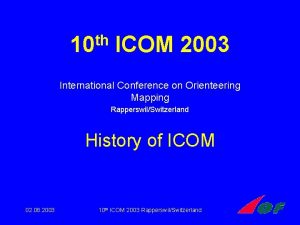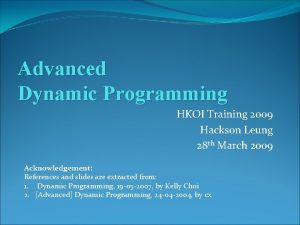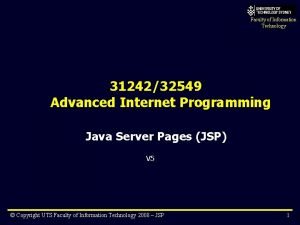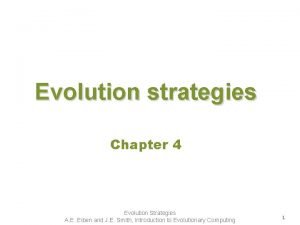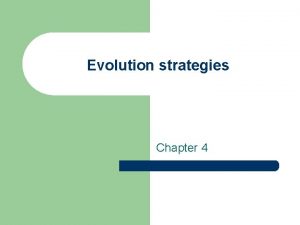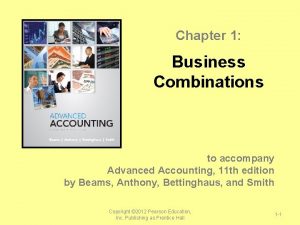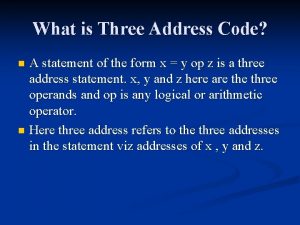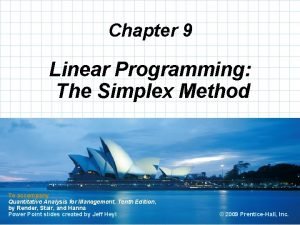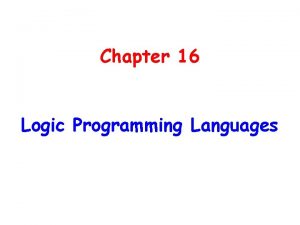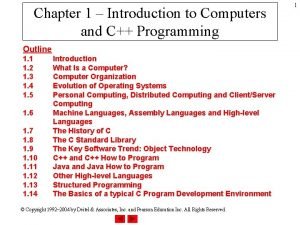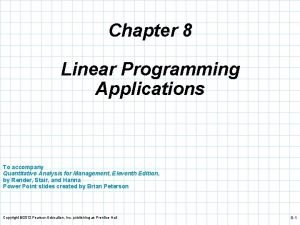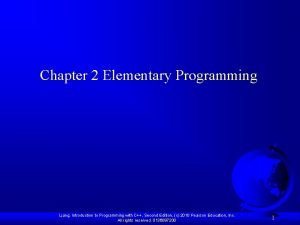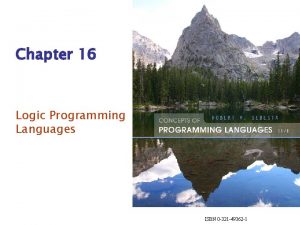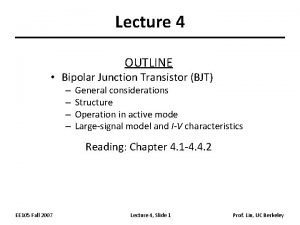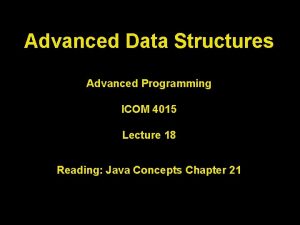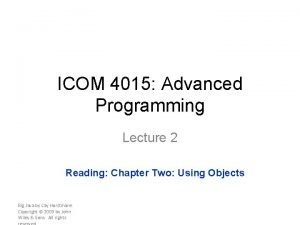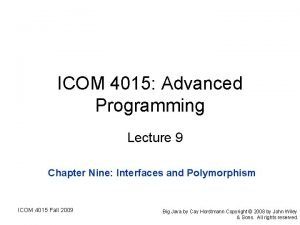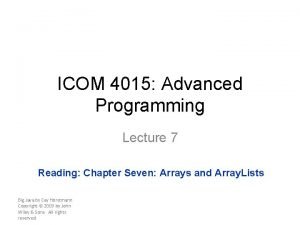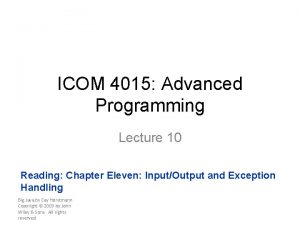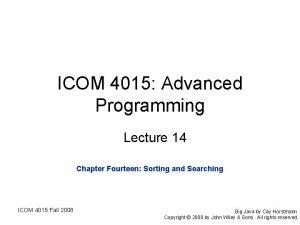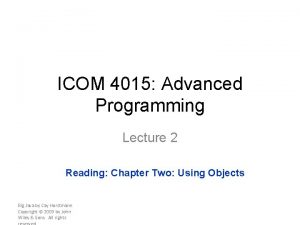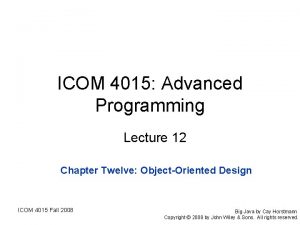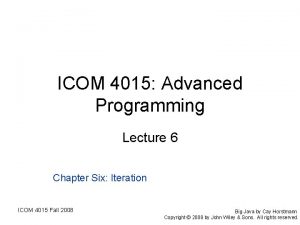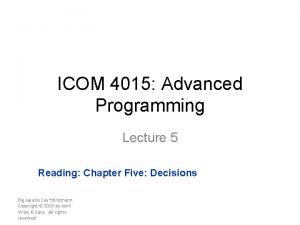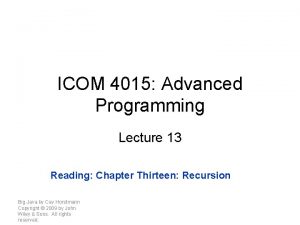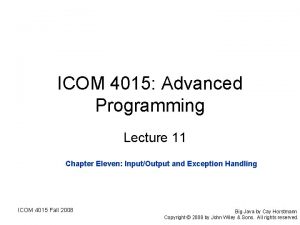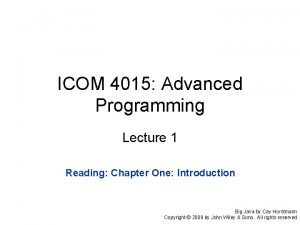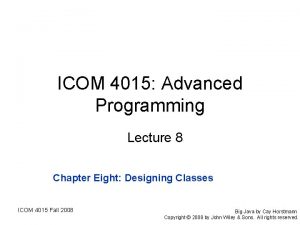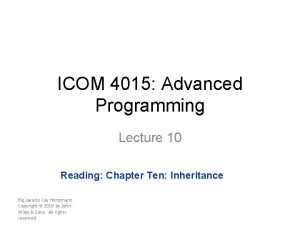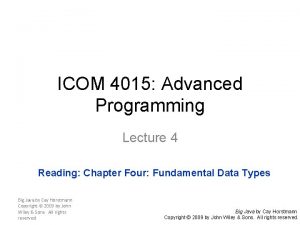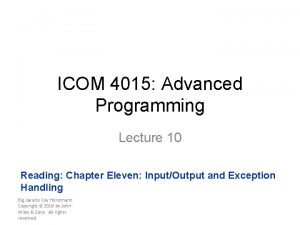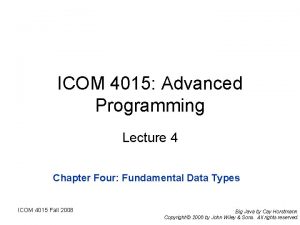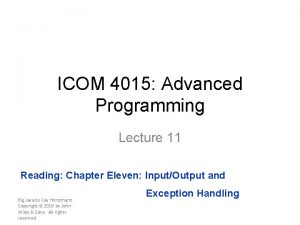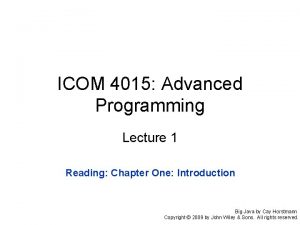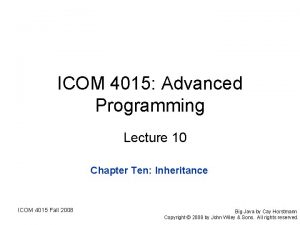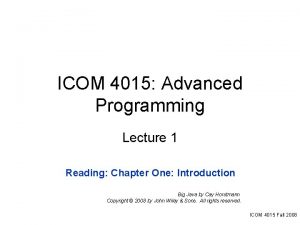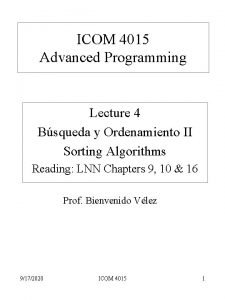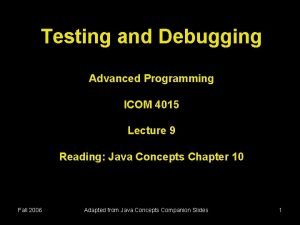ICOM 4015 Advanced Programming Lecture 3 Chapter Three

















































































- Slides: 81

ICOM 4015: Advanced Programming Lecture 3 Chapter Three: Implementing Classes

Chapter Three: Implementing Classes Big Java by Cay Horstmann Copyright © 2008 by John Wiley & Sons. All rights reserved.

Chapter Goals • To become familiar with the process of implementing classes • To be able to implement simple methods • To understand the purpose and use of constructors • To understand how to access instance fields and local variables • To appreciate the importance of documentation comments • To implement classes for drawing graphical shapes Big Java by Cay Horstmann Copyright © 2008 by John Wiley & Sons. All rights reserved.

Black Boxes • A black box magically does its thing • Hides its inner workings • Encapsulation: the hiding of unimportant details • What is the right concept for each particular black box? • Concepts are discovered through abstraction • Abstraction: taking away inessential features, until only the essence of the concept remains • In object-oriented programming the black boxes from which a program is manufactured are called objects Big Java by Cay Horstmann Copyright © 2008 by John Wiley & Sons. All rights reserved.

Levels of Abstraction: A Real Life Example • Black boxes in a car: transmission, electronic control module, etc. Big Java by Cay Horstmann Copyright © 2008 by John Wiley & Sons. All rights reserved.

Levels of Abstraction: A Real Life Example • Users of a car do not need to understand how black boxes work • Interaction of a black box with outside world is well-defined • Drivers interact with car using pedals, buttons, etc. • Mechanic can test that engine control module sends the right firing signals to the spark plugs • For engine control module manufacturers, transistors and capacitors are black boxes magically produced by an electronics component manufacturer • Encapsulation leads to efficiency: • Mechanic deals only with car components (e. g. electronic control module), not with sensors and transistors • Driver worries only about interaction with car (e. g. putting gas in the tank), not about motor or electronic control module Big Java by Cay Horstmann Copyright © 2008 by John Wiley & Sons. All rights reserved.

Levels of Abstraction: Software Design Big Java by Cay Horstmann Copyright © 2008 by John Wiley & Sons. All rights reserved.

Levels of abstraction: Software Design • Old times: computer programs manipulated primitive types such as numbers and characters • Manipulating too many of these primitive quantities is too much for programmers and leads to errors • Solution: Encapsulate routine computations to software black boxes • Abstraction used to invent higher-level data types • In object-oriented programming, objects are black boxes • Encapsulation: Programmer using an object knows about its behavior, but not about its internal structure Continued Big Java by Cay Horstmann Copyright © 2008 by John Wiley & Sons. All rights reserved.

Levels of abstraction: Software Design (cont. ) • In software design, you can design good and bad abstractions with equal facility; understanding what makes good design is an important part of the education of a software engineer • First, define behavior of a class; then, implement it Big Java by Cay Horstmann Copyright © 2008 by John Wiley & Sons. All rights reserved.

Self Check 3. 1 In Chapters 1 and 2, you used System. out as a black box to cause output to appear on the screen. Who designed and implemented System. out? Answer: The programmers who designed and implemented the Java library. Big Java by Cay Horstmann Copyright © 2008 by John Wiley & Sons. All rights reserved.

Self Check 3. 2 Suppose you are working in a company that produces personal finance software. You are asked to design and implement a class for representing bank accounts. Who will be the users of your class? Answer: Other programmers who work on the personal finance application. Big Java by Cay Horstmann Copyright © 2008 by John Wiley & Sons. All rights reserved.

Specifying the Public Interface of a Class Behavior of bank account (abstraction): • deposit money • withdraw money • get balance Big Java by Cay Horstmann Copyright © 2008 by John Wiley & Sons. All rights reserved.

Specifying the Public Interface of a Class: Methods of Bank. Account class: • deposit • withdraw • get. Balance We want to support method calls such as the following: harrys. Checking. deposit(2000); harrys. Checking. withdraw(500); System. out. println(harrys. Checking. get. Balance()); Big Java by Cay Horstmann Copyright © 2008 by John Wiley & Sons. All rights reserved.

Specifying the Public Interface of a Class: Method Definition access specifier (such as public) • return type (such as String or void) • method name (such as deposit) • list of parameters (double amount for deposit) • method body in { } Examples: • public void deposit(double amount) {. . . } • public void withdraw(double amount) {. . . } • public double get. Balance() {. . . } Big Java by Cay Horstmann Copyright © 2008 by John Wiley & Sons. All rights reserved.

Syntax 3. 1 Method Definition access. Specifier return. Type method. Name(parameter. Type parameter. Name, . . . ) { method body } Example: public void deposit(double amount) {. . . } Purpose: To define the behavior of a method. Big Java by Cay Horstmann Copyright © 2008 by John Wiley & Sons. All rights reserved.

Specifying the Public Interface of a Class: Constructor Definition • A constructor initializes the instance fields • Constructor name = class name public Bank. Account() { // body--filled in later } • Constructor body is executed when new object is created • Statements in constructor body will set the internal data of the object that is being constructed • All constructors of a class have the same name • Compiler can tell constructors apart because they take different Big Java by Cay Horstmann parameters Copyright © 2008 by John Wiley & Sons. All rights reserved.

Syntax 3. 2 Constructor Definition access. Specifier Class. Name(parameter. Type parameter. Name, . . . ) { constructor body } Example: public Bank. Account(double initial. Balance) {. . . } Purpose: To define the behavior of a constructor. Big Java by Cay Horstmann Copyright © 2008 by John Wiley & Sons. All rights reserved.

Bank. Account Public Interface The public constructors and methods of a class form the public interface of the class. public class Bank. Account { // Constructors public Bank. Account() { // body--filled in later } public Bank. Account(double initial. Balance) { // body--filled in later } Continued Big Java by Cay Horstmann Copyright © 2008 by John Wiley & Sons. All rights reserved.

Bank. Account Public Interface (cont. ) // Methods public void deposit(double amount) { // body--filled in later } public void withdraw(double amount) { // body--filled in later } public double get. Balance() { // body--filled in later } // private fields--filled in later } Big Java by Cay Horstmann Copyright © 2008 by John Wiley & Sons. All rights reserved.

Syntax 3. 3 Class Definition access. Specifier class Class. Name { constructors methods fields } Example: public class Bank. Account { public Bank. Account(double initial. Balance) {. . . } public void deposit(double amount) {. . . } Purpose: To define a class, its public interface, and its implementation Big Java by Cay Horstmann details. Copyright © 2008 by John Wiley & Sons. All rights reserved.

Self Check 3. 3 How can you use the methods of the public interface to empty the harrys. Checking bank account? Answer: harrys. Checking. withdraw(harrys. Checking. get. Balance()) Big Java by Cay Horstmann Copyright © 2008 by John Wiley & Sons. All rights reserved.

Self Check 3. 4 Suppose you want a more powerful bank account abstraction that keeps track of an account number in addition to the balance. How would you change the public interface to accommodate this enhancement? Answer: Add an account. Number parameter to the constructors, and add a get. Account. Number method. There is no need for a set. Account. Number method – the account number never changes after construction. Big Java by Cay Horstmann Copyright © 2008 by John Wiley & Sons. All rights reserved.

Commenting the Public Interface /** Withdraws money from the bank account. @param the amount to withdraw */ public void withdraw(double amount) { //implementation filled in later } /** Gets the current balance of the bank account. @return the current balance */ public double get. Balance() { //implementation filled in later } Big Java by Cay Horstmann Copyright © 2008 by John Wiley & Sons. All rights reserved.

Class Comment /** A bank account has a balance that can be changed by deposits and withdrawals. */ public class Bank. Account {. . . } • Provide documentation comments for • • every class every method every parameter every return value. Big Java by Cay Horstmann Copyright © 2008 by John Wiley & Sons. All rights reserved.

Javadoc Method Summary Big Java by Cay Horstmann Copyright © 2008 by John Wiley & Sons. All rights reserved.

Javadoc Method Detail Big Java by Cay Horstmann Copyright © 2008 by John Wiley & Sons. All rights reserved.

Self Check 3. 5 Suppose we enhance the Bank. Account class so that each account has an account number. Supply a documentation comment for the constructor public Bank. Account(int account. Number, double initial. Balance) Answer: /** Constructs a new bank account with a given initial balance. @param account. Number the account number for this account @param initial. Balance the initial balance for this account */ Big Java by Cay Horstmann Copyright © 2008 by John Wiley & Sons. All rights reserved.

Self Check 3. 6 Why is the following documentation comment questionable? /** Each account has an account number. @return the account number of this account */ public int get. Account. Number() Answer: The first sentence of the method description should describe the method – it is displayed in isolation in the summary table. Big Java by Cay Horstmann Copyright © 2008 by John Wiley & Sons. All rights reserved.

Instance Fields • An object stores its data in instance fields • Field: a technical term for a storage location inside a block of memory • Instance of a class: an object of the class • The class declaration specifies the instance fields public class Bank. Account {. . . private double balance; } Big Java by Cay Horstmann Copyright © 2008 by John Wiley & Sons. All rights reserved.

Instance Fields • An instance field declaration consists of the following parts: • access specifier (usually private) • type of variable (such as double) • name of variable (such as balance) • Each object of a class has its own set of instance fields • You should declare all instance fields as private Big Java by Cay Horstmann Copyright © 2008 by John Wiley & Sons. All rights reserved.

Instance Fields Big Java by Cay Horstmann Copyright © 2008 by John Wiley & Sons. All rights reserved.

Syntax 3. 4 Instance Field Declaration access. Specifier class Class. Name {. . . access. Specifier field. Type field. Name; . . . } Example: public class Bank. Account {. . . private double balance; . . . } Purpose: To define a field that is present in every object of a class. Big Java by Cay Horstmann Copyright © 2008 by John Wiley & Sons. All rights reserved.

Accessing Instance Fields • The deposit method of the Bank. Account class can access the private instance field: public void deposit(double amount) { double new. Balance = balance + amount; balance = new. Balance; } Continued Big Java by Cay Horstmann Copyright © 2008 by John Wiley & Sons. All rights reserved.

Accessing Instance Fields (cont. ) • Other methods cannot: public class Bank. Robber { public static void main(String[] args) { Bank. Account moms. Savings = new Bank. Account(1000); . . . moms. Savings. balance = -1000; // ERROR } } • Encapsulation is the process of hiding object data and providing methods for data access • To encapsulate data, declare instance fields as private and define public methods that access the fields Big Java by Cay Horstmann Copyright © 2008 by John Wiley & Sons. All rights reserved.

Self Check 3. 7 Suppose we modify the Bank. Account class so that each bank account has an account number. How does this change affect the instance fields? Answer: An instance field private int account. Number; needs to be added to the class. Big Java by Cay Horstmann Copyright © 2008 by John Wiley & Sons. All rights reserved.

Self Check 3. 8 What are the instance fields of the Rectangle class? Answer: There are four fields, x, y, width and height. All four fields have type int. Big Java by Cay Horstmann Copyright © 2008 by John Wiley & Sons. All rights reserved.

Implementing Constructors • Constructors contain instructions to initialize the instance fields of an object public Bank. Account() { balance = 0; } public Bank. Account(double initial. Balance) { balance = initial. Balance; } Big Java by Cay Horstmann Copyright © 2008 by John Wiley & Sons. All rights reserved.

Constructor Call Example • Bank. Account harrys. Checking = new Bank. Account(1000); • Create a new object of type Bank. Account • Call the second constructor (since a construction parameter is supplied) • Set the parameter variable initial. Balance to 1000 • Set the balance instance field of the newly created object to initial. Balance • Return an object reference, that is, the memory location of the object, as the value of the new expression • Store that object reference in the harrys. Checking variable Big Java by Cay Horstmann Copyright © 2008 by John Wiley & Sons. All rights reserved.

Implementing Methods • Some methods do not return a value public void withdraw(double amount) { double new. Balance = balance - amount; balance = new. Balance; } • Some methods return an output value public double get. Balance() { return balance; } Big Java by Cay Horstmann Copyright © 2008 by John Wiley & Sons. All rights reserved.

Method Call Example • harrys. Checking. deposit(500); • Set the parameter variable amount to 500 • Fetch the balance field of the object whose location is stored in harrys. Checking • Add the value of amount to balance and store the result in the variable new. Balance • Store the value of new. Balance in the balance instance field, overwriting the old value Big Java by Cay Horstmann Copyright © 2008 by John Wiley & Sons. All rights reserved.

Syntax 3. 5 The return Statement return expression; or return; Example: return balance; Purpose: To specify the value that a method returns, and exit the method immediately. The return value becomes the value of the method call expression. Big Java by Cay Horstmann Copyright © 2008 by John Wiley & Sons. All rights reserved.

ch 03/account/Bank. Account. java 01: 02: 03: 04: 05: 06: 07: 08: 09: 10: 11: 12: 13: 14: 15: 16: 17: 18: 19: 20: 21: 22: 23: /** A bank account has a balance that can be changed by deposits and withdrawals. */ public class Bank. Account { /** Constructs a bank account with a zero balance. */ public Bank. Account() { balance = 0; } /** Constructs a bank account with a given balance. @param initial. Balance the initial balance */ public Bank. Account(double initial. Balance) { balance = initial. Balance; } Continued Big Java by Cay Horstmann Copyright © 2008 by John Wiley & Sons. All rights reserved.

ch 03/account/Bank. Account. java (cont. ) 24: 25: 26: 27: 28: 29: 30: 31: 32: 33: 34: 35: 36: 37: 38: 39: 40: 41: 42: 43: 44: 45: 46: 47: /** Deposits money into the bank account. @param amount the amount to deposit */ public void deposit(double amount) { double new. Balance = balance + amount; balance = new. Balance; } /** Withdraws money from the bank account. @param amount the amount to withdraw */ public void withdraw(double amount) { double new. Balance = balance - amount; balance = new. Balance; } /** Gets the current balance of the bank account. Continued @return the current balance Big Java by Cay Horstmann */ Copyright © 2008 by John Wiley & Sons. All rights reserved.

ch 03/account/Bank. Account. java (cont. ) 48: 49: 50: 51: 52: 53: 54: } public double get. Balance() { return balance; } private double balance; Big Java by Cay Horstmann Copyright © 2008 by John Wiley & Sons. All rights reserved.

Self Check 3. 9 The Rectangle class has four instance fields: x, y, width, and height. Give a possible implementation of the get. Width method. Answer: public int get. Width() { return width; } Big Java by Cay Horstmann Copyright © 2008 by John Wiley & Sons. All rights reserved.

Self Check 3. 10 Give a possible implementation of the translate method of the Rectangle class. Answer: There is more than one correct answer. One possible implementation is as follows: public { int x = int y = } void translate(int dx, int dy) newx = x + dx; newy = y + dy; newy; Big Java by Cay Horstmann Copyright © 2008 by John Wiley & Sons. All rights reserved.

Unit Testing • Unit test: verifies that a class works correctly in isolation, outside a complete program. • To test a class, use an environment for interactive testing, or write a tester class. • Test class: a class with a main method that contains statements to test another class. • Typically carries out the following steps: 1. Construct one or more objects of the class that is being tested 2. Invoke one or more methods 3. Print out one or more results Continued Big Java by Cay Horstmann Copyright © 2008 by John Wiley & Sons. All rights reserved.

Unit Testing (cont. ) • Details for building the program vary. In most environments, you need to carry out these steps: 1. 2. 3. 4. Make a new subfolder for your program Make two files, one for each class Compile both files Run the test program Big Java by Cay Horstmann Copyright © 2008 by John Wiley & Sons. All rights reserved.

ch 03/account/Bank. Account. Tester. java 01: 02: 03: 04: 05: 06: 07: 08: 09: 10: 11: 12: 13: 14: 15: 16: 17: 18: /** A class to test the Bank. Account class. */ public class Bank. Account. Tester { /** Tests the methods of the Bank. Account class. @param args not used */ public static void main(String[] args) { Bank. Account harrys. Checking = new Bank. Account(); harrys. Checking. deposit(2000); harrys. Checking. withdraw(500); System. out. println(harrys. Checking. get. Balance()); System. out. println("Expected: 1500"); } } Output: 1500 Expected: 1500 Big Java by Cay Horstmann Copyright © 2008 by John Wiley & Sons. All rights reserved.

Testing With Blue. J Big Java by Cay Horstmann Copyright © 2008 by John Wiley & Sons. All rights reserved.

Self Check 3. 11 When you run the Bank. Account. Tester program, how many objects of class Bank. Account are constructed? How many objects of type Bank. Account. Tester? Answer: One Bank. Account object, no Bank. Account. Tester object. The purpose of the Bank. Account. Tester class is merely to hold the main method. Big Java by Cay Horstmann Copyright © 2008 by John Wiley & Sons. All rights reserved.

Self Check 3. 12 Why is the Bank. Account. Tester class unnecessary in development environments that allow interactive testing, such as Blue. J? Answer: In those environments, you can issue interactive commands to construct Bank. Account objects, invoke methods, and display their return values. Big Java by Cay Horstmann Copyright © 2008 by John Wiley & Sons. All rights reserved.

Categories of Variables • Categories of variables 1. Instance fields (balance in Bank. Account) 2. Local variables (new. Balance in deposit method) 3. Parameter variables (amount in deposit method) • An instance field belongs to an object • The fields stay alive until no method uses the object any longer • In Java, the garbage collector periodically reclaims objects when they are no longer used 1. Local and parameter variables belong to a method 2. Instance fields are initialized to a default value, but you must initialize local variables Big Java by Cay Horstmann Copyright © 2008 by John Wiley & Sons. All rights reserved.

Animation 3. 1 – Big Java by Cay Horstmann Copyright © 2008 by John Wiley & Sons. All rights reserved.

Lifetime of Variables – Calling Method deposit harrys. Checking. deposit(500); Big Java by Cay Horstmann Copyright © 2008 by John Wiley & Sons. All rights reserved.

Lifetime of Variables – Calling Method deposit harrys. Checking. deposit(500); Big Java by Cay Horstmann Copyright © 2008 by John Wiley & Sons. All rights reserved.

Lifetime of Variables – Calling Method deposit harrys. Checking. deposit(500); double new. Balance = balance + amount; Big Java by Cay Horstmann Copyright © 2008 by John Wiley & Sons. All rights reserved.

Lifetime of Variables – Calling Method deposit harrys. Checking. deposit(500); double new. Balance = balance + amount; balance = new. Balance; Big Java by Cay Horstmann Copyright © 2008 by John Wiley & Sons. All rights reserved.

Self Check 3. 13 What do local variables and parameter variables have in common? In which essential aspect do they differ? Answer: Variables of both categories belong to methods – they come alive when the method is called, and they die when the method exits. They differ in their initialization. Parameter variables are initialized with the call values; local variables must be explicitly initialized. Big Java by Cay Horstmann Copyright © 2008 by John Wiley & Sons. All rights reserved.

Self Check 3. 14 During execution of the Bank. Account. Tester program in the preceding section, how many instance fields, local variables, and parameter variables were created, and what were their names? Answer: One instance field, named balance. Three local variables, one named harrys. Checking and two named new. Balance (in the deposit and withdraw methods); two parameter variables, both named amount (in the deposit and withdraw methods). Big Java by Cay Horstmann Copyright © 2008 by John Wiley & Sons. All rights reserved.

Implicit and Explicit Method Parameters • The implicit parameter of a method is the object on which the method is invoked • The this reference denotes the implicit parameter • Use of an instance field name in a method denotes the instance field of the implicit parameter public void withdraw(double amount) { double new. Balance = balance - amount; balance = new. Balance; } Continued Big Java by Cay Horstmann Copyright © 2008 by John Wiley & Sons. All rights reserved.

Implicit and Explicit Method Parameters (cont. ) • balance is the balance of the object to the left of the dot: moms. Savings. withdraw(500) means double new. Balance = moms. Savings. balance - amount; >moms. Savings. balance = new. Balance; Big Java by Cay Horstmann Copyright © 2008 by John Wiley & Sons. All rights reserved.

Implicit Parameters and this • Every method has one implicit parameter • The implicit parameter is always called this • Exception: Static methods do not have an implicit parameter (more on Chapter 8) • double new. Balance = balance + amount; // actually means double new. Balance = this. balance + amount; • When you refer to an instance field in a method, the compiler automatically applies it to the this parameter moms. Savings. deposit(500); Big Java by Cay Horstmann Copyright © 2008 by John Wiley & Sons. All rights reserved.

Implicit Parameters and this Big Java by Cay Horstmann Copyright © 2008 by John Wiley & Sons. All rights reserved.

Self Check 3. 15 How many implicit and explicit parameters does the withdraw method of the Bank. Account class have, and what are their names and types? Answer: One implicit parameter, called this, of type Bank. Account, and one explicit parameter, called amount, of type double. Big Java by Cay Horstmann Copyright © 2008 by John Wiley & Sons. All rights reserved.

Self Check 3. 16 In the deposit method, what is the meaning of this. amount? Or, if the expression has no meaning, why not? Answer: It is not a legal expression. this is of type Bank. Account and the Bank. Account class has no field named amount. Big Java by Cay Horstmann Copyright © 2008 by John Wiley & Sons. All rights reserved.

Self Check 3. 17 How many implicit and explicit parameters does the main method of the Bank. Account. Tester class have, and what are they called? Answer: No implicit parameter–the method is static–and one explicit parameter, called args. Big Java by Cay Horstmann Copyright © 2008 by John Wiley & Sons. All rights reserved.

Shape Classes Good practice: Make a class for each graphical shape public class Car { public Car(int x, int y) { // Remember position. . . } public void draw(Graphics 2 D g 2) { // Drawing instructions. . . } } Big Java by Cay Horstmann Copyright © 2008 by John Wiley & Sons. All rights reserved.

Drawing Cars • Draw two cars: one in top-left corner of window, and another in the bottom right • Compute bottom right position, inside paint. Component method: int x = get. Width() - 60; int y = get. Height() - 30; Car car 2 = new Car(x, y); • get. Width and get. Height are applied to object that executes paint. Component • If window is resized paint. Component is called and car position recomputed Continued Big Java by Cay Horstmann Copyright © 2008 by John Wiley & Sons. All rights reserved.

Drawing Cars (cont. ) Big Java by Cay Horstmann Copyright © 2008 by John Wiley & Sons. All rights reserved.

Plan Complex Shapes on Graph Paper Big Java by Cay Horstmann Copyright © 2008 by John Wiley & Sons. All rights reserved.

Classes of Car Drawing Program • Car: responsible for drawing a single car • Two objects of this class are constructed, one for each car • Car. Component: displays the drawing • Car. Viewer: shows a frame that contains a Car. Component Big Java by Cay Horstmann Copyright © 2008 by John Wiley & Sons. All rights reserved.

ch 03/car/Car. java 01: 02: 03: 04: 05: 06: 07: 08: 09: 10: 11: 12: 13: 14: 15: 16: 17: 18: 19: 20: 21: 22: import import java. awt. Graphics 2 D; java. awt. Rectangle; java. awt. geom. Ellipse 2 D; java. awt. geom. Line 2 D; java. awt. geom. Point 2 D; /** A car shape that can be positioned anywhere on the screen. */ public class Car { /** Constructs a car with a given top left corner @param x the x coordinate of the top left corner @param y the y coordinate of the top left corner */ public Car(int x, int y) { x. Left = x; y. Top = y; } Continued Big Java by Cay Horstmann Copyright © 2008 by John Wiley & Sons. All rights reserved.

ch 03/car/Car. java (cont. ) 23: 24: 25: 26: 27: 28: 29: 30: 31: 32: 33: 34: 35: 36: 37: 38: 39: 40: 41: 42: 43: 44: 45: /** Draws the car. @param g 2 the graphics context */ public void draw(Graphics 2 D g 2) { Rectangle body = new Rectangle(x. Left, y. Top + 10, 60, 10); Ellipse 2 D. Double front. Tire = new Ellipse 2 D. Double(x. Left + 10, y. Top + 20, 10); Ellipse 2 D. Double rear. Tire = new Ellipse 2 D. Double(x. Left + 40, y. Top + 20, 10); // The bottom of the front windshield Point 2 D. Double r 1 = new Point 2 D. Double(x. Left + 10, y. Top + 10); // The front of the roof Point 2 D. Double r 2 = new Point 2 D. Double(x. Left + 20, y. Top); // The rear of the roof Point 2 D. Double r 3 = new Point 2 D. Double(x. Left + 40, y. Top); Continued // The bottom of the rear windshield Big Java by Cay Horstmann Copyright © 2008 by John Wiley & Sons. All rights reserved.

ch 03/car/Car. java (cont. ) 46: 47: 48: 49: 50: 51: 52: 53: 54: 55: 56: 57: 58: 59: 60: 61: 62: 63: 64: 65: 66: } Point 2 D. Double r 4 = new Point 2 D. Double(x. Left + 50, y. Top + 10); Line 2 D. Double front. Windshield = new Line 2 D. Double(r 1, r 2); Line 2 D. Double roof. Top = new Line 2 D. Double(r 2, r 3); Line 2 D. Double rear. Windshield = new Line 2 D. Double(r 3, r 4); g 2. draw(body); g 2. draw(front. Tire); g 2. draw(rear. Tire); g 2. draw(front. Windshield); g 2. draw(roof. Top); g 2. draw(rear. Windshield); } private int x. Left; private int y. Top; Big Java by Cay Horstmann Copyright © 2008 by John Wiley & Sons. All rights reserved.

ch 03/car/Car. Component. java 01: 02: 03: 04: 05: 06: 07: 08: 09: 10: 11: 12: 13: 14: 15: 16: 17: 18: 19: 20: 21: 22: 23: 24: import java. awt. Graphics; import java. awt. Graphics 2 D; import javax. swing. JComponent; /** This component draws two car shapes. */ public class Car. Component extends JComponent { public void paint. Component(Graphics g) { Graphics 2 D g 2 = (Graphics 2 D) g; Car car 1 = new Car(0, 0); int x = get. Width() - 60; int y = get. Height() - 30; Car car 2 = new Car(x, y); car 1. draw(g 2); car 2. draw(g 2); } } Big Java by Cay Horstmann Copyright © 2008 by John Wiley & Sons. All rights reserved.

ch 03/car/Car. Viewer. java 01: 02: 03: 04: 05: 06: 07: 08: 09: 10: 11: 12: 13: 14: 15: 16: 17: 18: 19: import javax. swing. JFrame; public class Car. Viewer { public static void main(String[] args) { JFrame frame = new JFrame(); frame. set. Size(300, 400); frame. set. Title("Two cars"); frame. set. Default. Close. Operation(JFrame. EXIT_ON_CLOSE); Car. Component component = new Car. Component(); frame. add(component); frame. set. Visible(true); } } Big Java by Cay Horstmann Copyright © 2008 by John Wiley & Sons. All rights reserved.

Self Check 3. 18 Which class needs to be modified to have the two cars positioned next to each other? Answer: Car. Component Big Java by Cay Horstmann Copyright © 2008 by John Wiley & Sons. All rights reserved.

Self Check 3. 19 Which class needs to be modified to have the car tires painted in black, and what modification do you need to make? Answer: In the draw method of the Car class, call g 2. fill(front. Tire); g 2. fill(rear. Tire); Big Java by Cay Horstmann Copyright © 2008 by John Wiley & Sons. All rights reserved.

Self Check 3. 20 How do you make the cars twice as big? Answer: Double all measurements in the draw method of the Car class. Big Java by Cay Horstmann Copyright © 2008 by John Wiley & Sons. All rights reserved.

Drawing Graphical Shapes Rectangle left. Rectangle = new Rectangle(100, 30, 60); Rectangle right. Rectangle = new Rectangle(160, 100, 30, 60); Line 2 D. Double top. Line = new Line 2 D. Double(130, 100, 160, 100); Line 2 D. Double bottom. Line = new Line 2 D. Double(130, 160, 160); Big Java by Cay Horstmann Copyright © 2008 by John Wiley & Sons. All rights reserved.
 Icom ic-2730a vs kenwood tm-v71a
Icom ic-2730a vs kenwood tm-v71a Papasys
Papasys ämaps
ämaps Icom
Icom Bayaran balik emolumen tl
Bayaran balik emolumen tl 01:640:244 lecture notes - lecture 15: plat, idah, farad
01:640:244 lecture notes - lecture 15: plat, idah, farad Advanced inorganic chemistry lecture notes
Advanced inorganic chemistry lecture notes C programming lecture
C programming lecture Dynamic programming bottom up
Dynamic programming bottom up Advanced internet programming
Advanced internet programming A simple assembly scheme in system software
A simple assembly scheme in system software Assembler
Assembler Advanced programming in java
Advanced programming in java Perbedaan linear programming dan integer programming
Perbedaan linear programming dan integer programming Greedy vs dynamic programming
Greedy vs dynamic programming What is system programming
What is system programming Integer programming vs linear programming
Integer programming vs linear programming Perbedaan linear programming dan integer programming
Perbedaan linear programming dan integer programming Management fifteenth edition
Management fifteenth edition Human resource management chapter 1
Human resource management chapter 1 Human resource management lecture chapter 1
Human resource management lecture chapter 1 Chapter 6 shielded metal arc welding
Chapter 6 shielded metal arc welding Advanced evolution chapter 4
Advanced evolution chapter 4 Advanced evolution chapter 4
Advanced evolution chapter 4 Advanced part modeling
Advanced part modeling Advanced accounting chapter 1
Advanced accounting chapter 1 Hobbits and orcs problem solution
Hobbits and orcs problem solution Othello act 3 summary
Othello act 3 summary In three minutes write three things you did yesterday
In three minutes write three things you did yesterday Purpose of traffic signs
Purpose of traffic signs The three colonial sections-one society or three
The three colonial sections-one society or three Three addresses in three address code are
Three addresses in three address code are Python chapter 5 programming exercises
Python chapter 5 programming exercises Chapter 9 linear programming
Chapter 9 linear programming Prolog reverse list
Prolog reverse list Chapter 16 programming language
Chapter 16 programming language Linear programming models graphical and computer methods
Linear programming models graphical and computer methods Computer programming chapter 1
Computer programming chapter 1 Chapter 1 introduction to computers and programming
Chapter 1 introduction to computers and programming Computer programming chapter 1
Computer programming chapter 1 History of python
History of python Chapter 8 linear programming applications solutions
Chapter 8 linear programming applications solutions Chapter 2 elementary programming
Chapter 2 elementary programming Chapter 16 programming language
Chapter 16 programming language Chapter 1 introduction to computers and programming
Chapter 1 introduction to computers and programming Project procurement management lecture notes
Project procurement management lecture notes Lecture about sport
Lecture about sport Lecture on healthy lifestyle
Lecture on healthy lifestyle Nihilism vs existentialism
Nihilism vs existentialism Life lecture meaning
Life lecture meaning Randy pausch last lecture summary
Randy pausch last lecture summary Tensorflow lecture
Tensorflow lecture Theology proper lecture notes
Theology proper lecture notes Strategic management lecture
Strategic management lecture Geology lecture series
Geology lecture series Social psychology lecture
Social psychology lecture In text citation for a lecture
In text citation for a lecture Public sector accounting lecture notes in kenya
Public sector accounting lecture notes in kenya 4 p's of project management in software engineering
4 p's of project management in software engineering Practical design to eurocode 2
Practical design to eurocode 2 Electricity and magnetism lecture notes
Electricity and magnetism lecture notes Classical mechanics
Classical mechanics Physics 101 lecture notes pdf
Physics 101 lecture notes pdf Physical science lecture notes
Physical science lecture notes Power system dynamics and stability lecture notes
Power system dynamics and stability lecture notes Natural language processing
Natural language processing Microbial physiology notes
Microbial physiology notes Application of mechatronics ppt
Application of mechatronics ppt Limits fits and tolerances
Limits fits and tolerances Lecture primaire
Lecture primaire Instruction de lecture et d'écriture
Instruction de lecture et d'écriture Lecture carte aéronautique
Lecture carte aéronautique Lecture title
Lecture title Slidetodoc
Slidetodoc Financial engineering lecture notes
Financial engineering lecture notes Quasi saturation in power bjt
Quasi saturation in power bjt Requirement analysis in software engineering notes
Requirement analysis in software engineering notes Katus lighting
Katus lighting Le registre pathétique dans le dernier jour d'un condamné
Le registre pathétique dans le dernier jour d'un condamné Tegrity lecture capture
Tegrity lecture capture Types of social letters
Types of social letters Bjt iv
Bjt iv


